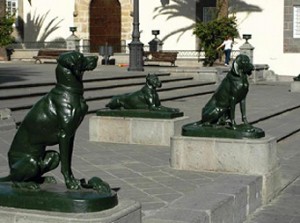Dog Statues of Spain
118 – August, 2016
Text and illustrations by Ria Hörter
Text in quotations courtesy Manuel Curtó Gracia and Manuel Martín Béthencourt, authors of Perro de Presa Canario and El Presa Canario
 Los Perros de la Plaza de Santa Ana
Los Perros de la Plaza de Santa Ana
Las Palmas, Gran Canaria
In 2004, I traveled to the Spanish Canary Islands and visited four of them – Gran Canaria, La Gomera, Lanzarote and Tenerife – not to lie on the beaches for hours or to swim in the almost-forever blue sea, but to experience the old Spanish culture and unspoiled islands. In the city of Las Palmas on Gran Canaria, I visited the Vegueta, the oldest part of the city.
Volcanic Islands
The mountainous Canary Islands, which came into being from volcanic eruptions, form an archipelago off the northwest coast of mainland Africa. One of the islands, Gran Canaria, rises almost 13,000 feet above sea level; at some places between the islands, the sea is 1,000 feet deep. The Canaries are a popular holiday destination for Europeans.
Their name in Spanish, Islas Canarias, is likely derived from the Latin name Canariae Insulae meaning Canine Islands. According to Pliny the Elder, a Roman author and naturalist, the Mauritanian (African) King Juba II (25 BC to AD 23) named the island Canaria because of its “vast multitudes of dogs of very large size.” It is said that the aboriginal inhabitants of Gran Canaria, the Guanches, worshipped dogs, mummified them and treated them as holy animals.
The islands were visited by Phoenicians, Greeks and Carthaginians, and in 40 BC by the Romans. Sailors from Spain, Portugal and Italy visited the islands from the 14th century onward, and some attempts were made to colonize the archipelago.
In 1402, French explorer Jean de Béthencourt claimed the island of Lanzarote for Castile, and by the end of the 15th century, all islands of the archipelago were under Spanish authority. Today, the Canaries are one of Spain’s 17 autonomous communities.
Spanish authority was not only a political matter; people, goods, animals – dogs! – were shipped to the islands and the society was developed along the lines of the Spanish example.
Click here to read the complete article118 – August, 2016
Short URL: https://caninechronicle.com/?p=110025
Comments are closed











